This post may contain affiliate links, which means that I may receive a commission if you make a purchase using these links.
Early spring foraging is one of the best times to find tasty common wild edibles in the Northeast. This is the complete guide to finding and eating some of my favorites.
Early spring is an exciting to get outside and forage for wild edibles in the Northeast. Mother Nature is just starting to awaken–days get longer, the temperatures rise, and trees start to bud.
It also happens to be a time when many edible plants plants are at their tastiest. In the early spring, you can forage shoots, tender greens, and immature fronds. Some plants’ roots and greens are tenderized by “overwintering,” AKA freezing over the winter and thawing in the spring.
Many of these same plants will become too fibrous or even dangerous to eat in later seasons.
Early spring foraging season is ephemeral. I encourage you to get out there and make the most of early spring foraging with my guide to some of my favorite edibles below!
This post is all about early spring foraging.
Note: Please use caution when foraging plants for consumption. Do not eat foods you are not comfortable with identifying.
Early Spring Foraging Edible Plants
Dandelion (Taraxacum officinale)
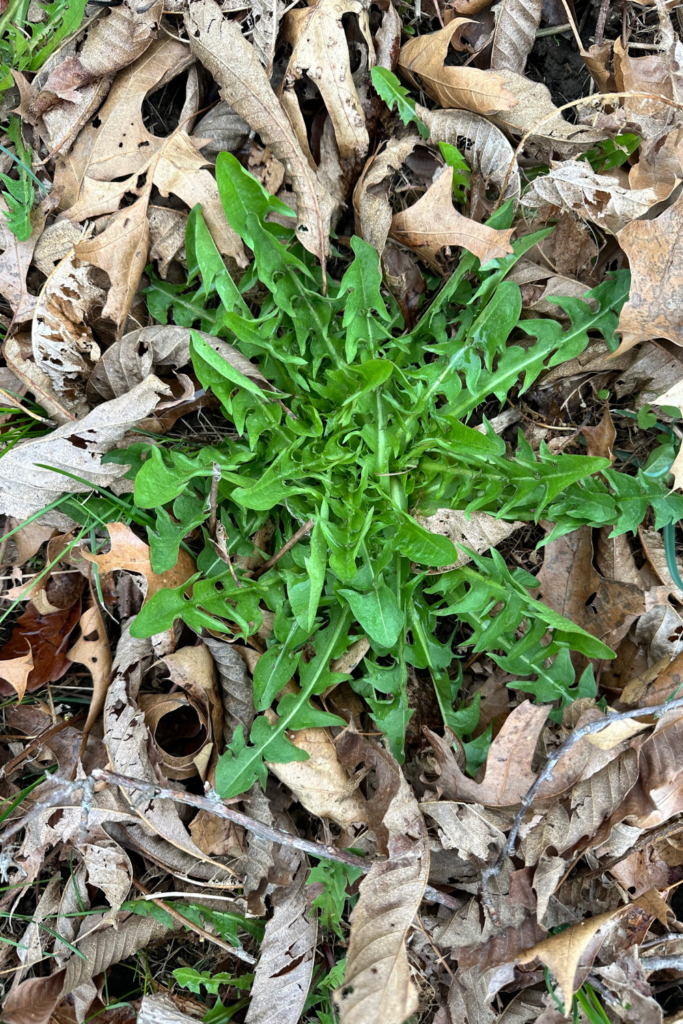
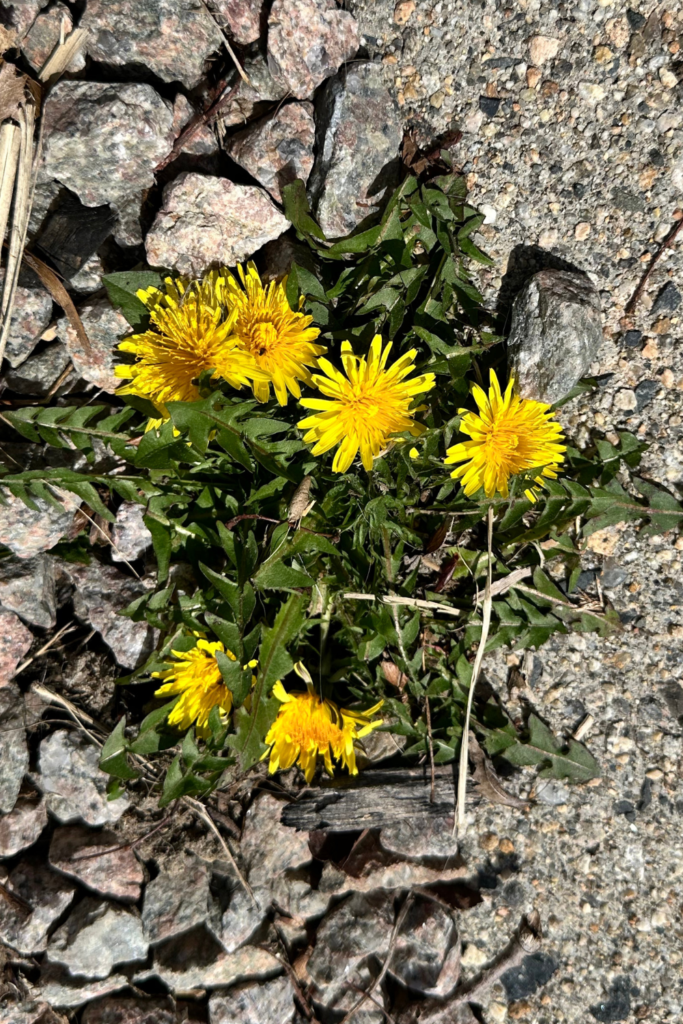
Dandelion are an excellent foraging find for beginners. Dandelions are so named for their jagged, lions’ teeth leaves.
How to find: In the early spring, dandelions won’t have put out their easily-identifiable yellow flowers. However, around this time dandelions can be identified by their leaves, which will be growing in a rosette shape low to the ground. The leaves look like arrow heads pointing away from the center of the rosette.
How to eat: Dandelion leaves are at their most delicious in the early spring, and can be eaten raw as a salad green. Eat them before the flower stalk comes up! However, all parts of the dandelion are edible, with the flower and root having medicinal properties.
Stinging nettle (Urtica dioica)
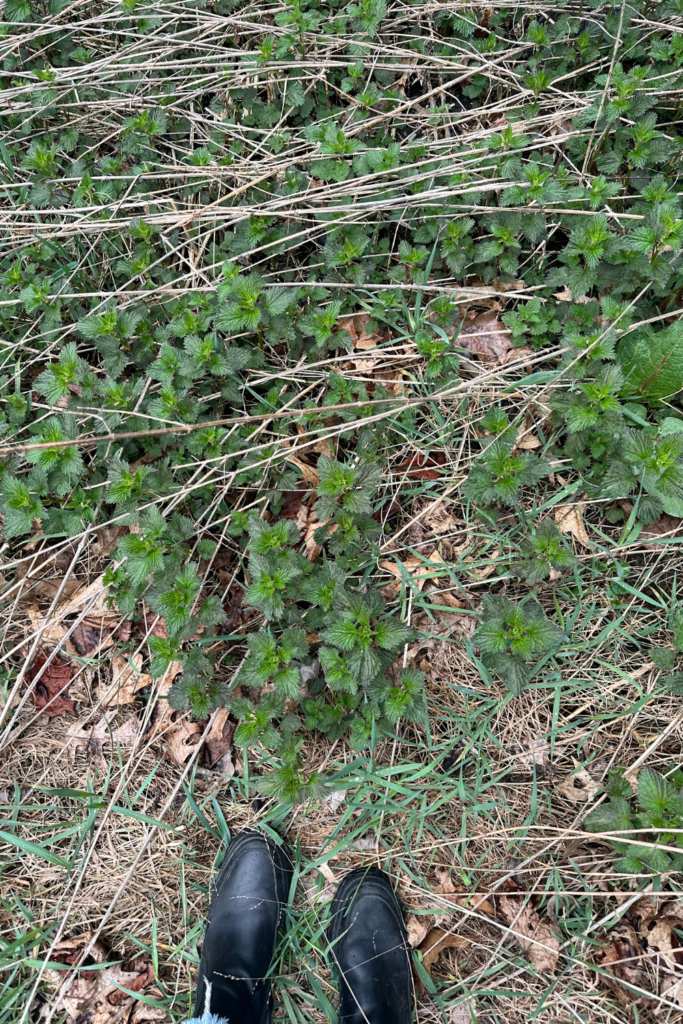
Stinging nettle gets its name from its fine, hair-like structures that contain irritants that burn or sting when touched. However, the early spring is the perfect time to collect stinging nettle because these hairs are not fully developed and you can harvest barehanded!
How to find: Why would you want to harvest such a feisty plant? Well, stinging nettle is chock full vitamins, minerals and antioxidants. As such, stinging nettle has been a staple health tonic in many ancient herbal medicine practices.
How to eat: The stinging hairs can be deactivated by cooking or drying. I like to drink nettle as a tea, and dry bunches of it in my dehydrator every spring. Stinging nettle can also be used as a replacement for spinach. Blanching is the ideal cooking method for stinging nettle. Blanch nettle by boiling in hot water for three minutes and cooling in an ice water bath.
Japanese knotweed (Reynoutria japonica)
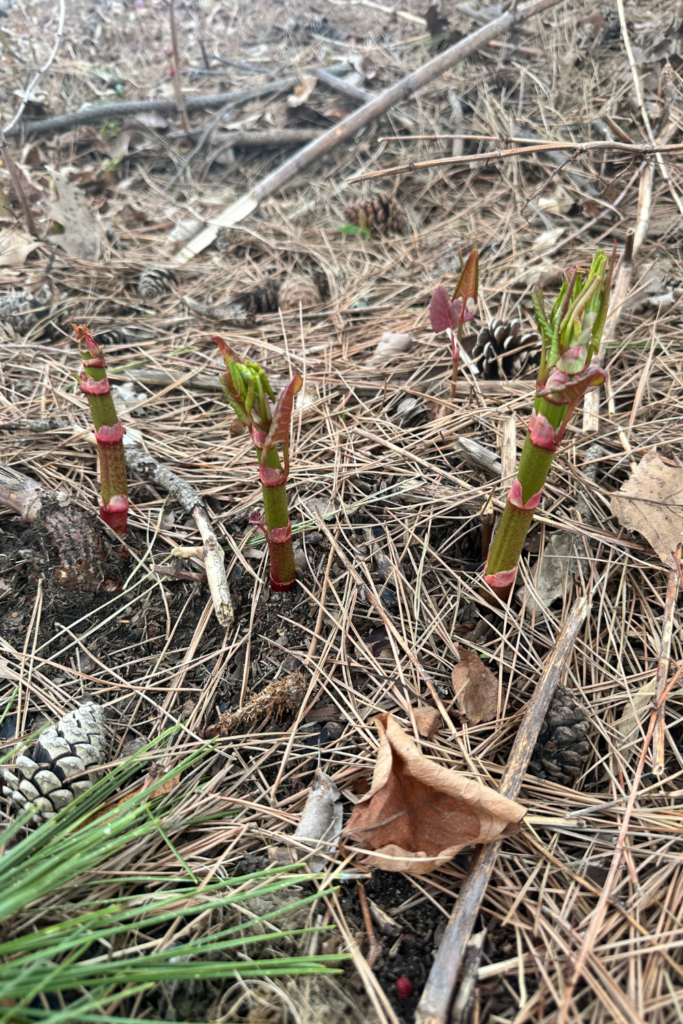
Japanese knotweed is a pernicious plant that is invasive to North America. Luckily, it is tasty and we can do our part to control populations by harvesting the shoots!
How to find: Edible Japanese knotweed shoots are available in early spring. They look sort of look like alien asparagus. Japanese knotweed shoots are green with red splotches, and will typically be thicker than commercial asparagus.
How to eat: Japanese knotweed can be enjoyed in savory and sweet applications. It is especially good pickled or used as a replacement for rhubarb in strawberry rhubarb pie. Check out Forager Chef’s guide to cooking with Japanese knotweed.
Garlic mustard (Alliaria petiolata)

Garlic mustard is invasive to North America. I would encourage you to pull the entire plant out of the ground when harvesting to do your part in controlling this pervasive plant!
How to find: Once you learn to identify garlic mustard, you will see it everywhere. Leaves are heart-shaped and broadly toothed. First-year plants grow in small rosettes close to the ground. These plants will become mature, flowering second-year plants the following season. However, garlic mustard is perhaps best identified by ripping a leaf off and giving it a whiff–it will smell like garlic!
How to eat: I recommend eating second-year plants, as they are bigger, leafier, and tastier. Garlic mustard is an excellent addition in garlicky and green recipes like pesto.
Wild garlic/onion grass (Allium vineale)
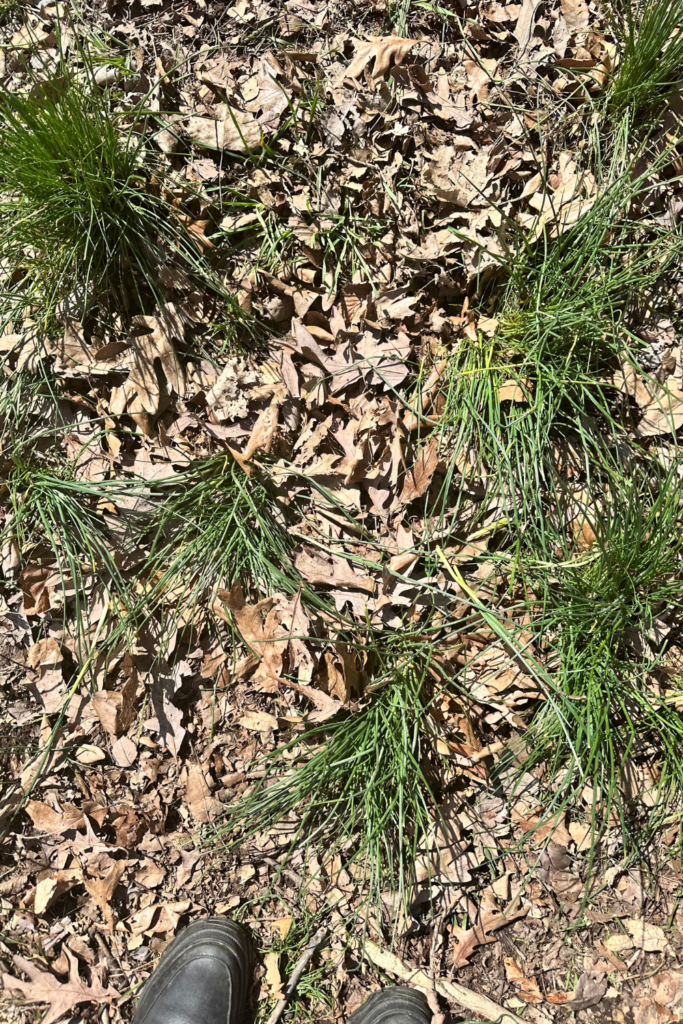
Wild garlic (also known colloquially as onion grass) is another invasive plant to North America that can be pulled from the ground entirely.
How to find: Wild garlic is fairly easy to identify in the early spring, as it will appear in tufts that are taller and greener than any surrounding true grass. Upon closer inspection, you’ll see that wild garlic leaves are hollow. Wild garlic is easily identified by smell. Tear a leaf and give it a whiff–it will smell like garlic!
How to eat: Wild garlic bulbs are excellent cooked anywhere you might use garlic–maybe sautéed with a steak for example. On the other hand, wild garlic leaves can be used as a replacement for chives in omelettes, dressings, etc.
Horsetail (Equisetum arvense)
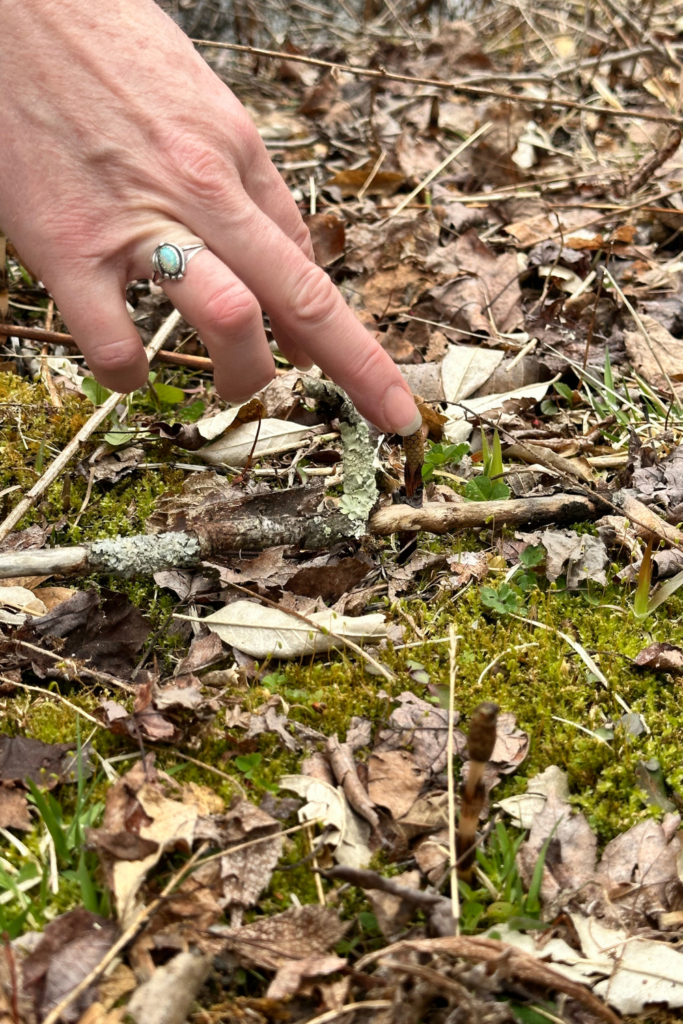
Horsetail is a prehistoric plant that first appeared during the Jurassic period. Today, it is native to nearly every place on earth, excluding Australia, New Zealand, and Antartica.
How to find: Horsetail gets its name from it long, hair-like whorls of branches that resemble a horse’s tail. (To me they look more like a scared cat’s tail or pipe cleaner!) The edible fertile shoot is striped in appearance.
How to eat: Horsetail shoots can be cooked and eaten like green beans.
Cattail shoots (Typha spp.)
Cattails are a plant familiar to many worldwide. However, the plant is known by many names across the globe. There are several species native to North America.
How to find: If you’ve visited a wetland, you’ve likely seen the corndog-like cluster of the female flower atop a tall reed. Cattails can be found at the edge of lakes, swamps, marshes, streams, and other wet areas. However, the edible shoots are only available in the early spring.
How to eat: Cattail shoots can be eaten raw or cooked. When processing cattail shoots to eat, it helps to think of them like leeks (they certainly look like leeks!) I like this video from Forager Chef about processing cattail shoots.
Evening primrose (Oenothera biennis)
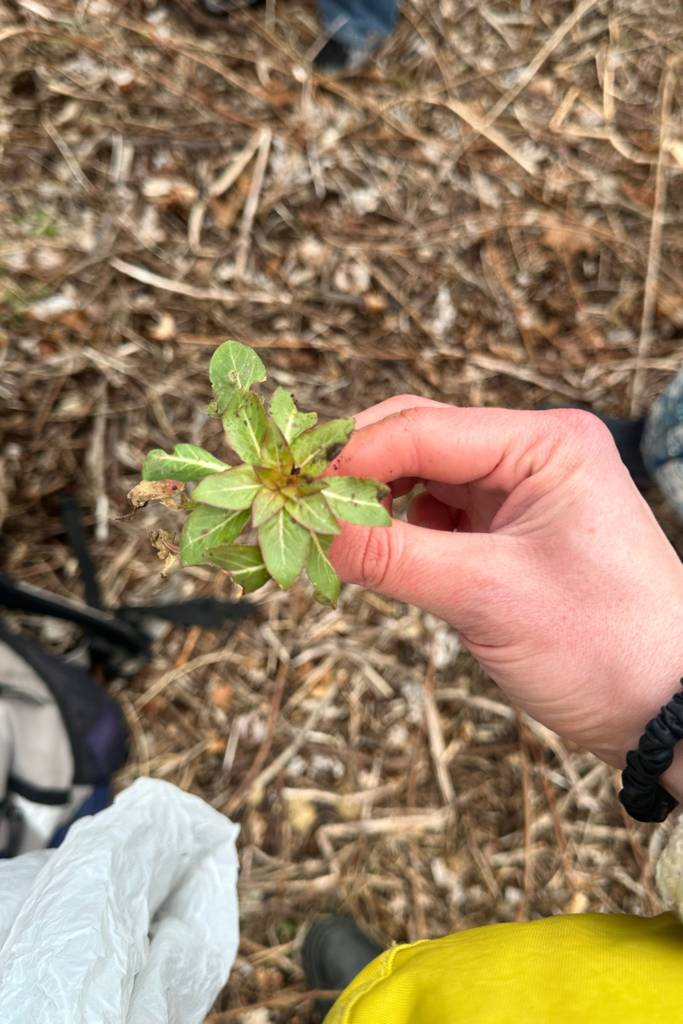
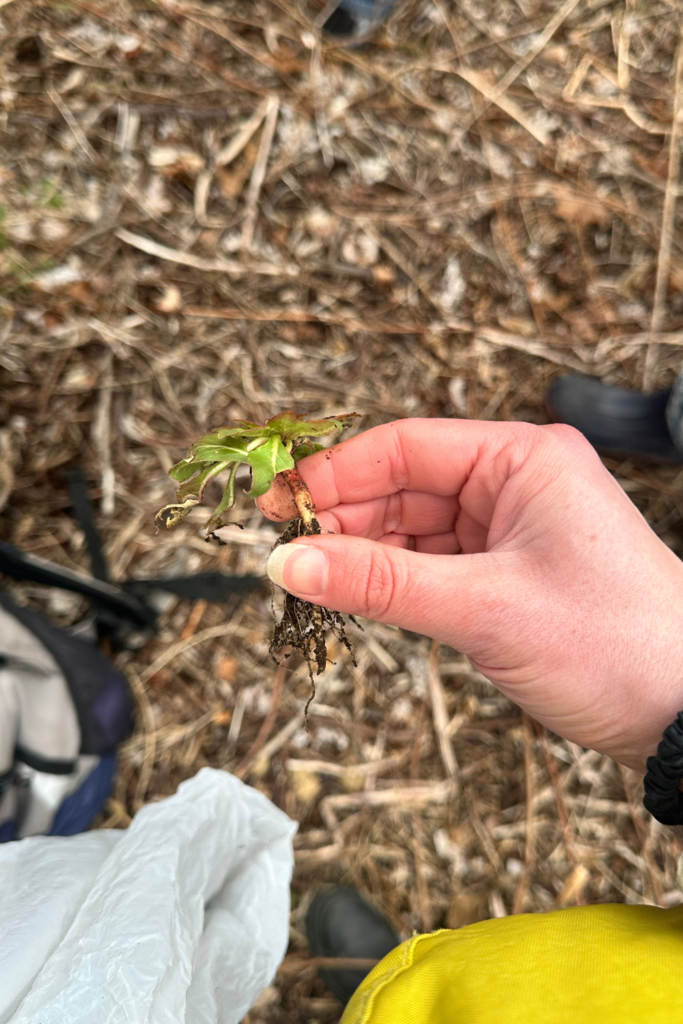
You may have heard of evening primrose via the popular evening primrose oil health supplements, made from the seed oil that is rich in omega-6 fatty acids. However, I like evening primrose for its tastier parts!
How to find: Evening primrose is native to North America, and is considered a common weed that likes disturbed environments. As such, evening primrose is easily forage-able in urban and suburban areas!
How to eat: In the early spring, the young leaves can be eaten raw as a salad green. However, the tastiest part of the plant is my opinion is actually the root, which can be cooked and eaten like potatoes.
Fiddlehead ferns, or the ostrich fern (Matteuccia struthiopteris)
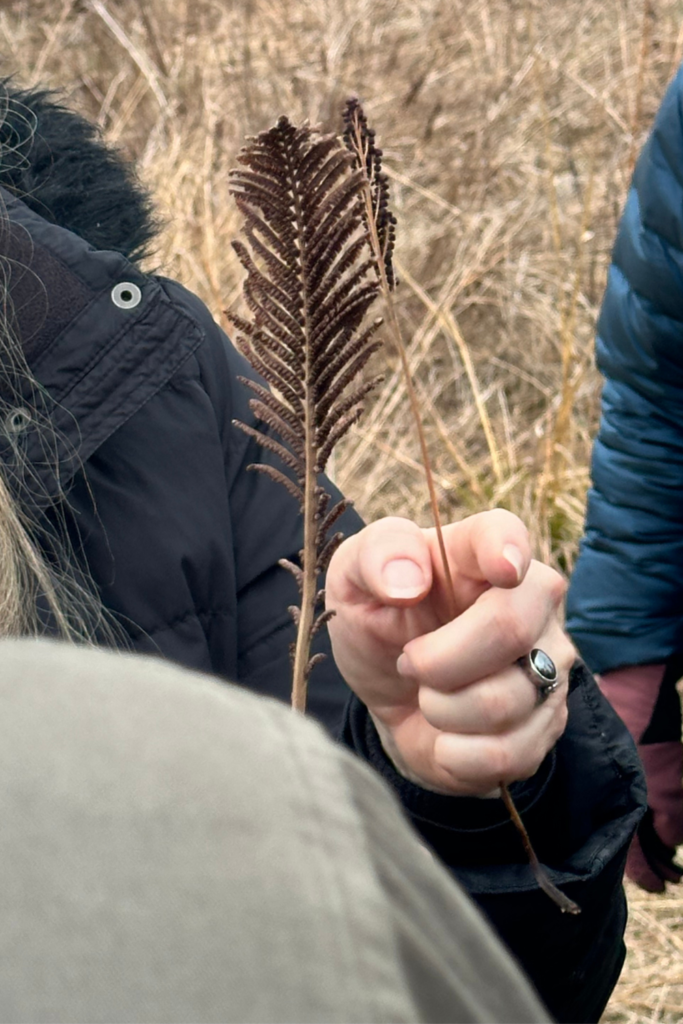
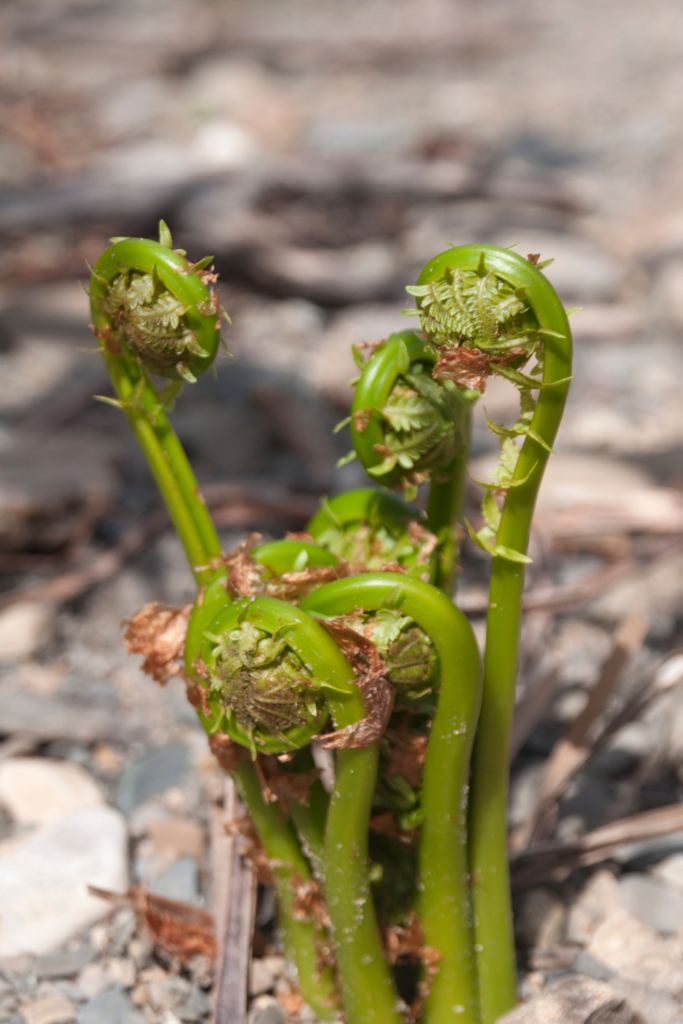
Fiddlehead ferns are the poster child of spring foraging. So called ‘fiddleheads’ are actually the immature fronds of the ostrich fern.
How to find: Mature ostrich ferns can be identified by their ostrich-feather appearance when they are mature and unfurled. The edible immature fronds have papery brown scales that can be scraped off before cooking. They also have a distinct U-shaped indent on the side of the stem.
How to eat: Do not eat fiddlehead ferns raw! Fiddlehead ferns need to be cooked before eating, as they contain a small amount of toxin that is removed by the cooking process. Fiddlehead ferns are an extremely tasty vegetable side that taste almost like asparagus.
Ramps (Allium tricoccum)
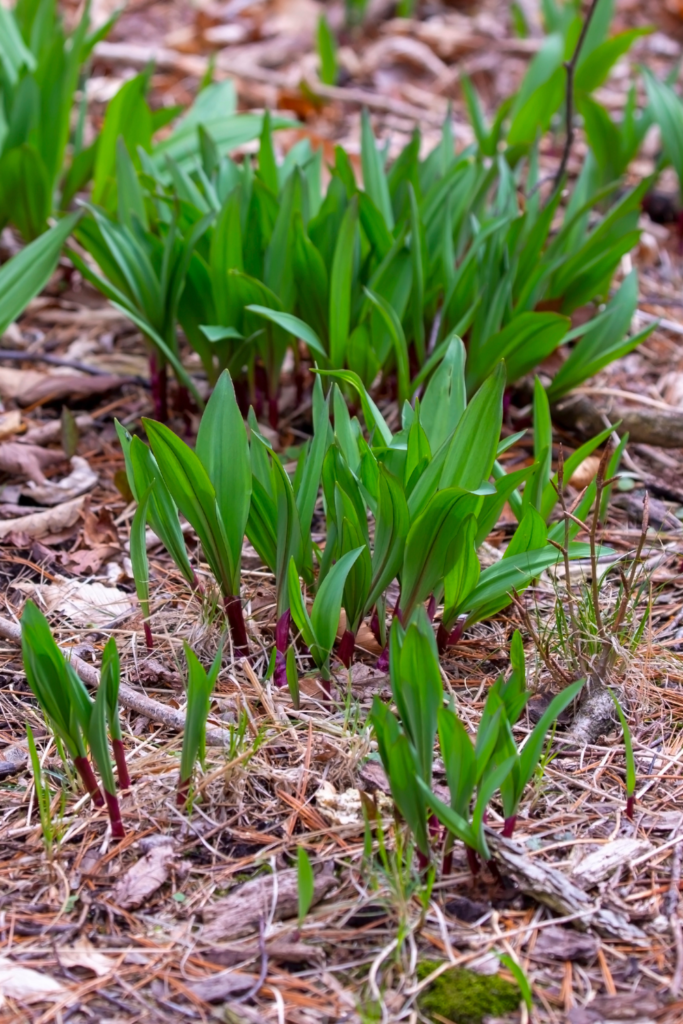
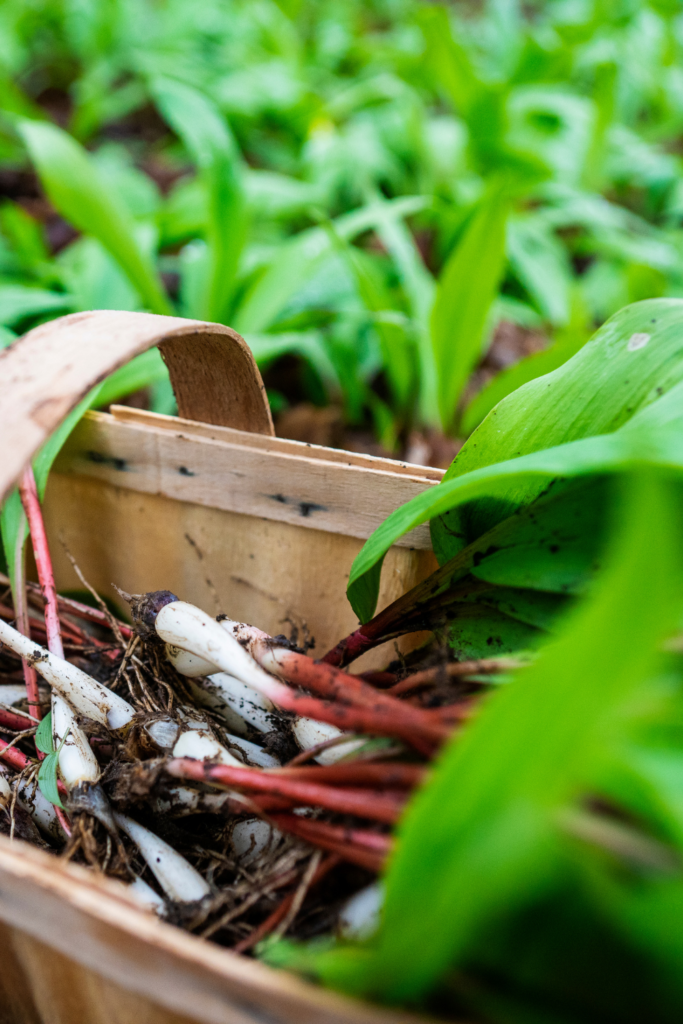
Ramps have become very popular among foodies in recent years for their garlicky flavor. However, they’ve been eaten for many centuries by Native Americans across the eastern United States and Canada.
How to find: Ramps typically grow in clusters of about 5-6 bulbs and have broad, smooth light green leaves.
How to eat: Ramps have been over-harvested in recent years. While technically you can eat both the bulb and the leaf, it is recommended to take one leaf from a cluster in an effort to conserve the ramp population. Ramps can be compounded into butter, incorporated into dressings, soups, and omelettes–basically use anywhere you would use garlic!
White pine (Pinus strobus)

Pine is the quintessential evergreen of the Northeast. But, did you know, pine needles are actually a very useful plant in the home and the kitchen?
Pine needles are purported for their high levels of vitamin C–up to three times the amount found in oranges.
How to find: Be careful identifying this one as some conifers are known to be toxic. There are some concerns around certain varieties of pine (Ponderosa pine, for example). Stick with Eastern White Pine (Pinus strobus) if you have concerns. White pine has five soft needles in a leaf packet.
How to eat: Pine needle tea is a traditional preparation to extract pine’s healthy goodness. Just collect, chop and steep a couple of tablespoons of pine needles in water for at least 5 minutes, like you would tea.
Another fun culinary use is to make pine sugar. Blend up equal parts pine needles and sugar until the needles are incorporated and the mixture is uniformly green. This is excellent in holiday cookies or as the sugar rim for festive cocktails.
Maple sap (Acer spp.)
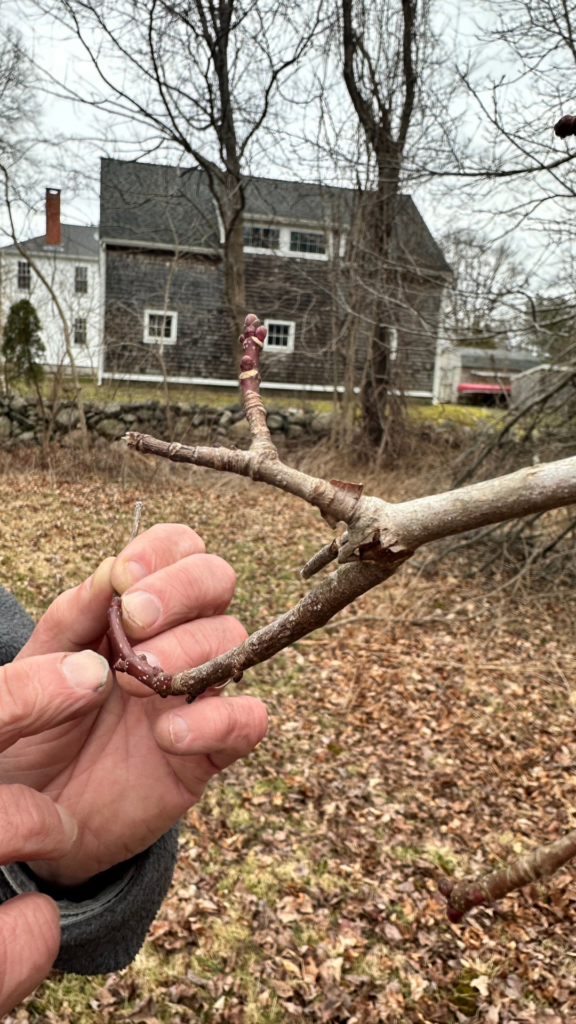
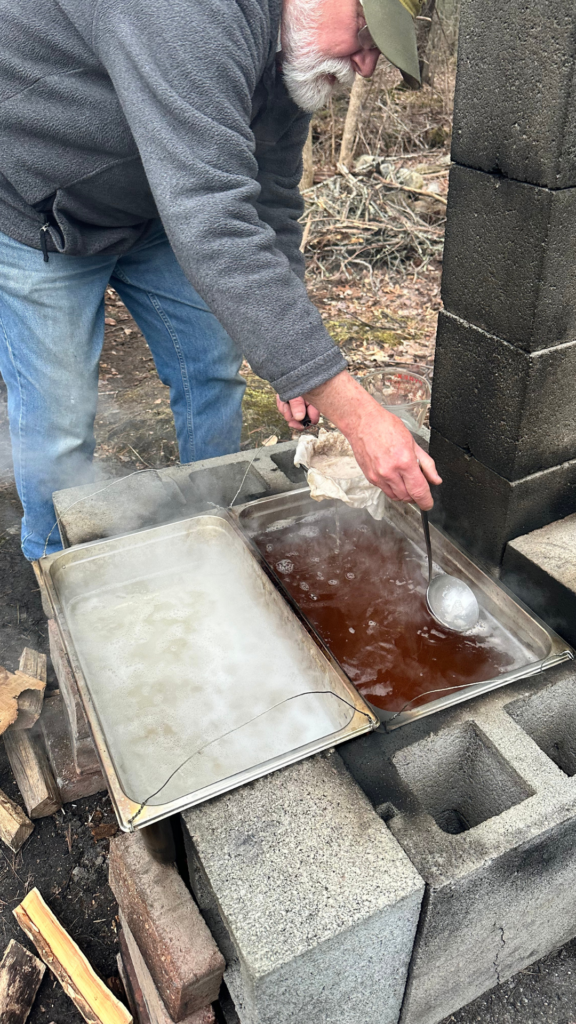
Making maple syrup is a fun late winter/early spring tradition. You can tap any maple tree that grows in the Eastern United States and Canada for sap, but sugar maples (Acer saccharinum) have the sweet sap. Maple trees are ready to tap when the overnight temperatures are below freezing and the daytime temperatures are around 40-45°F.
How to find: Maple tree leaves are lobed, with veins originating from the center to each point (usually 3-9 lobes depending on the species). Leaves turn brilliant colors (yellow, orange and red depending on the species) in the fall.
How to eat: Perhaps the most telling characteristic of the maple tree is it’s fruit. Often called “helicopters” or “whirlybirds,” the maple fruit has two wings attached that spin as they fall.
Read more in my guide on how to make maple syrup.
Birch sap (Betula spp.)
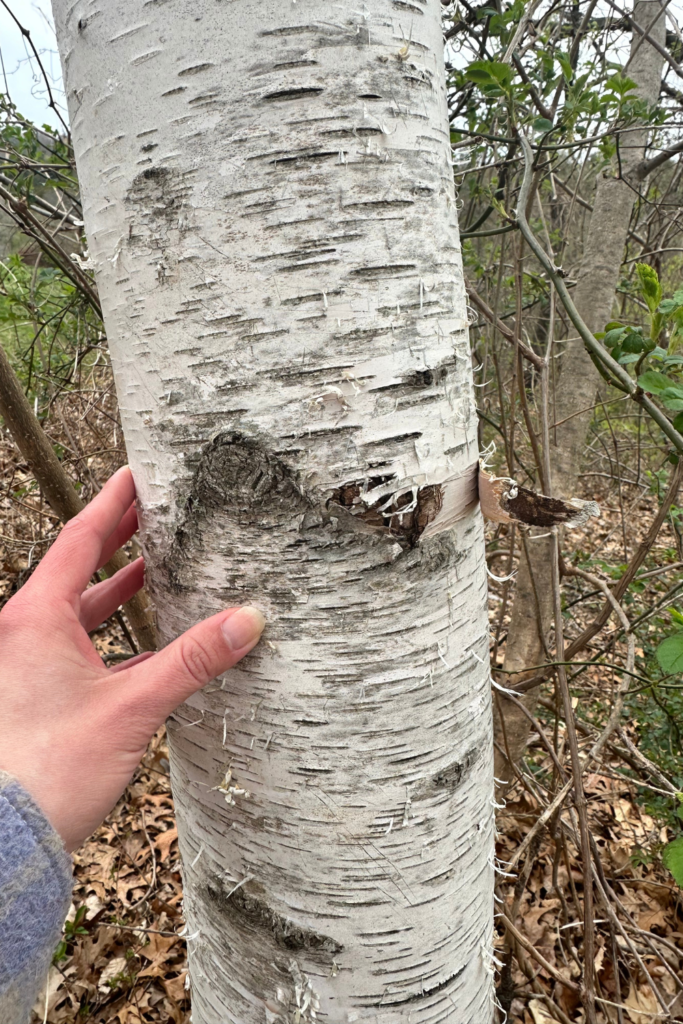
Why let maple syrup get all the fame? Just like maple syrup is the boiled down product, so too can you reduce birch sap into a sweet syrup. Birch sap runs a little later than maple sap, making this the perfect early spring foraging project. Birch sap season lasts until green leaves appear on the trees, usually sometime in April.
How to find: Birch trees are marked with long, horizontal “lenticels” that look like scars across the tree.
How to eat: Find a healthy tree that is at least 8 inches in diameter around the base. To tap a birch tree, drill a small hole slightly upwards a few centimeters into the tree. Insert a pipe or straw that fits the hole you created. The pipe should direct sap into a collection vessel secured below.
Boil sap over a flame outside (there will be a lot of evaporation) until it reduces to a brown, sweet liquid. Bring indoors to finish boiling on the stovetop until it reaches a syrupy consistency.
Birch syrup has more of a complex flavor compared to maple syrup. Enjoy birch syrup in ice cream, sodas, or even as in savory dishes as a sauce or glaze.
Hi, I’m Leslie, the founder of PunkMed
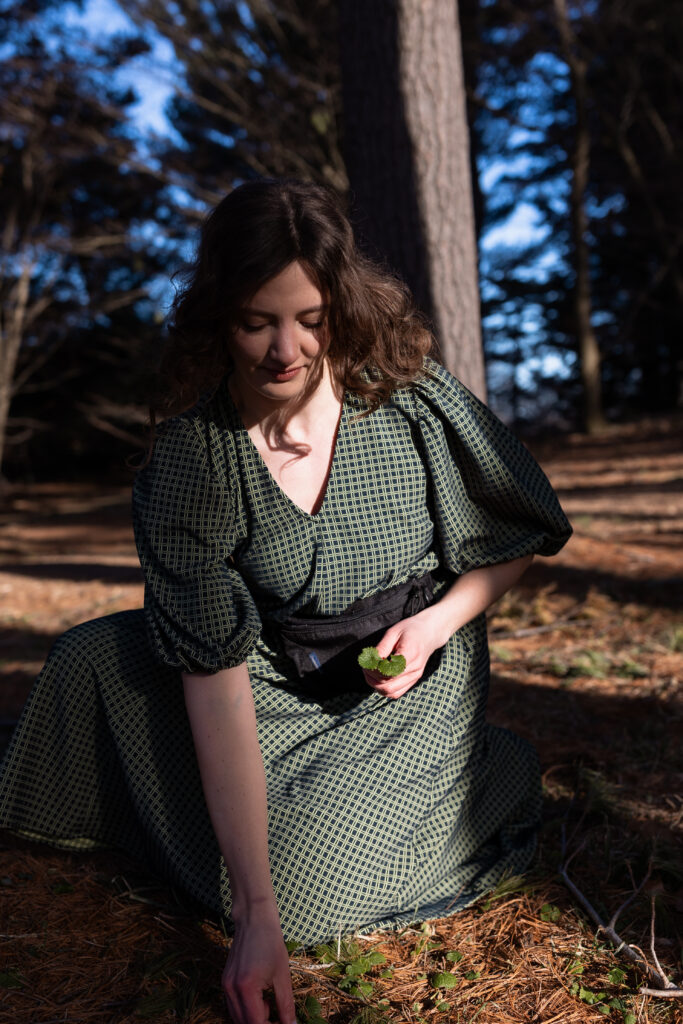
Hey friend! I’m so glad that you stopped by the blog today to learn about early spring foraging. Let me know what you find!
If you’re into wild food foraging, urban homesteading, or living a more sustainable life–stick around! There are a good number of resources on my blog, and I always love to hear from my readers (that’s you!) Feel free to send me a DM on Instagram!
Foraging Resources

This is my favorite field guide to finding edible plants in the Northeast and Central U.S.
This post is was all about early spring foraging.
